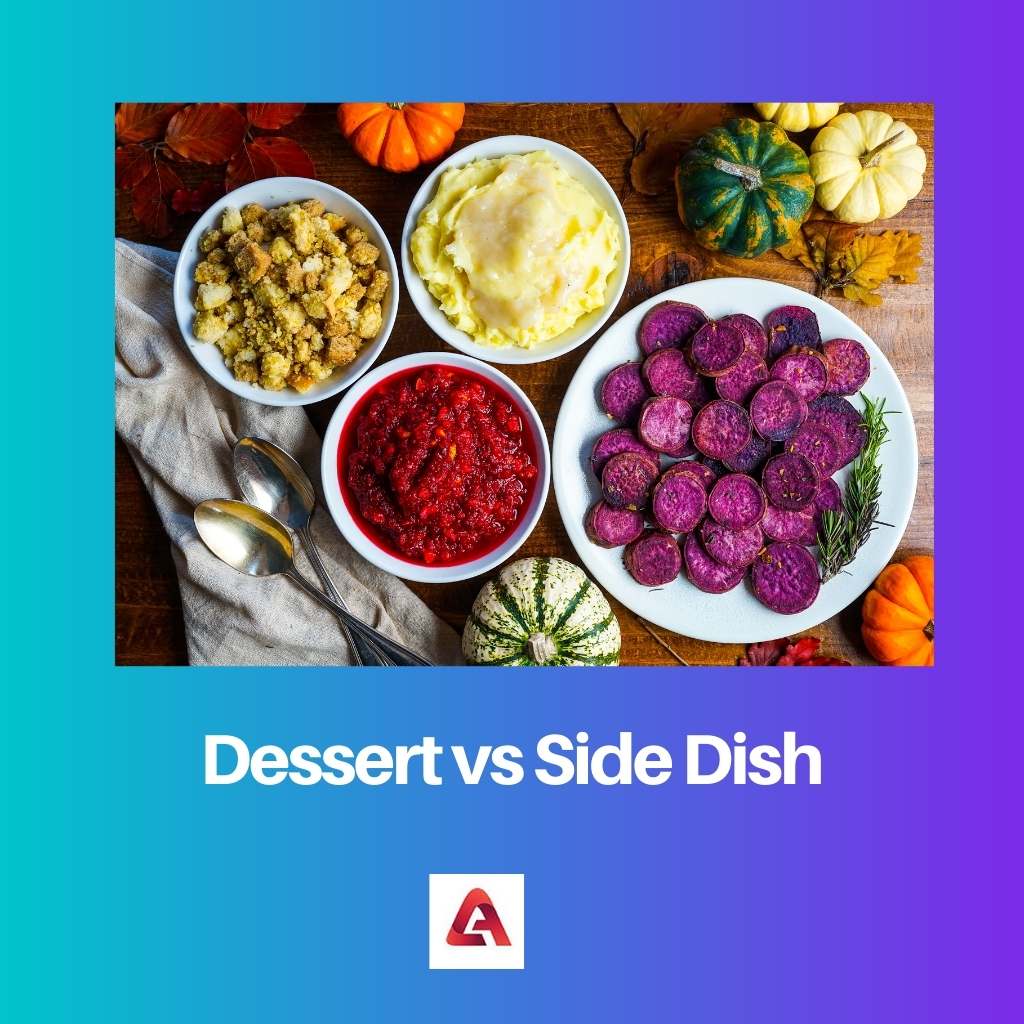Some people find it simple to distinguish the dessert from the side dish. All you have to do now is figure out which sweet foods are among the others. In a full dinner, the sweetest course in the desert. Desserts aren’t only for sweet meals, but they’ve built a name for themselves as sweet dishes. Many countries have evolved their unique dessert dishes, which include not-too-sweet cakes and pastries, soft ice creams, puddings, pies, chocolates, candies, gelatin, and other items. Fruits, too, maybe used as sweets because of their natural sweetness.
Key Takeaways
- Desserts are sweet courses served after a meal, while side dishes accompany the main course.
- Desserts include cakes, pies, and ice cream, while side dishes include vegetables, grains, and starches.
- Side dishes complement the main dish, while desserts have contrasting tastes and textures.
Dessert vs Side Dish
The difference between Desserts and Side Dishes is that Desserts are sweet, while side dishes are starchy. Before the main course, a side dish is offered. Its purpose is to allow guests to have something to do while waiting for the main course and to supplement beverage consumption. A “side dish” is a little piece of food served beside the main course.

Dessert is the last course of a meal. Sweet foods, such as confections, and occasionally a beverage, such as a dessert, wine or liqueur, make up the course. On the other hand, desserts are the last course of a meal. It includes items such as desserts or fruits, as well as a beverage such as wine or liqueur. Coffee, cheese, almonds, and other savoury treats cooked to the highest standards may be included. Because of its naturally inherent sweetness, fruit is frequently used in dessert dishes. Desserts are created by sweetening dishes that are normally salty.
A side dish is any dish that complements the main course. In addition to this basic description, side dishes can take many forms, from simple steamed vegetables to complex casseroles. In addition to adding variety to a meal’s taste profile, side dishes may also be used to sponge up sauces and gravies.
Comparison Table
| Parameters of Comparison | Dessert | Side Dish |
|---|---|---|
| Definition | A dessert is a sweet course served after a main course. Desserts are frequently consumed last. | A side dish is a starchy meal that is served beside the main course. Side dishes are frequently served alongside or in between main courses. |
| Taste | Mostly Sweet | Mix flavors |
| Offered | After main course | With main course |
| Served As | Small Amount | Small Amount |
| Examples | pies, chocolates, ice creams, puddings, gelatin, cakes, cookies, and more. | mashed or fried potatoes, rice, leafy salads, breads, pasta, and many more. |
What is Dessert?
Desserts are popular among almost everyone. Desserts made with milk may be a healthful, delightful, and satisfying way to receive vitamins, minerals, protein, and calories. Because the sweet dessert relaxes the stomach and allows for more capacity, it might cause discomfort when constricting. The body is trying all it can to speed up digestion and nutrient absorption, but it’s also sending signals to the brain to quit eating.
Their presence on the menu makes us feel full after a meal and helps to compensate for low blood sugar levels. A desire to elevate your mood by consuming sweets might also play a role. We produce more of the so-called happy hormone when we eat sweet foods. The majority of desserts are high in processed carbohydrates, trans fats, and added sugars. They are calorie-dense as a result of this, which may lead to weight gain (excess fat).
Too much of anything is harmful. Consequently, eating too much dessert might be hazardous to your health. Consider your health. Aside from the psychological benefits of a decent dose of chocolate, cookie cakes are healthier than conventional cakes. This is because they need less sugar but taste just as wonderful, if not better!

What is Side Dish?
When the main course is ordered, restaurants frequently provide a selection of side dishes, which normally adhere to the restaurant’s main cuisine. Many families eat only certain side dishes during certain holidays. A side dish’s characteristics might vary greatly. Dishes like steamed vegetables or a basket of bread rolls can be as simple as chicken liver mousse or chilled pea soup with creme fraiche and edible flowers or as complex as chicken liver mousse or chilled pea soup with crème Fraiche and edible flowers.
In order to “round out” a meal and give attractive taste contrasts, both home cooks and restaurants frequently combine main courses with one or two side dishes. Occasionally, a side dish tastes good and serves as a type of “sponge” for soaking up sauces and gravies. For example, in Indian main meals, meat cheese is cooked with a thick spicy sauce.
These recipes are paired with rice and flatbread. The restaurant offers one or more side dishes when ordering a main meal. The sides on offer are consistent with the restaurant’s overall food style. Many households reserve special side dishes for a certain holiday season.

Main Differences Between Dessert and Side Dish
- A dessert is a sweet course served after the main course. Desserts are frequently consumed last. On the other hand, a side dish is a starchy meal served beside the main course. Side dishes are frequently served alongside or in between main courses.
- Desserts are mostly sweet in taste, whereas side dishes have mix taste.
- Desserts are offered after the main course, whereas side dishes are offered with the main course.
- Smaller amounts of desserts and side dishes are offered.
- Examples include pie, chocolate, ice cream, puddings, candies, cakes, cookies, gelatin, and other sweets. Mashed or fried potatoes, green vegetable salads, bread, rice, spaghetti, and a variety of other side dishes are examples of side dishes.




